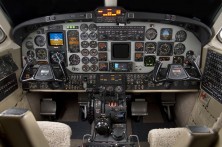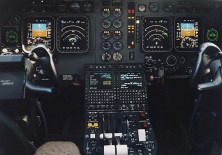By Bill Forbes – Director of Avionics Sales for Elliott Aviation
 Parts obsolescence is inevitable in aviation. The longer the aircraft has been in circulation, the harder it can be to find parts. This especially holds true in avionics because of the parallels they have with consumer electronics. The components that make up the avionics found in the cockpit weren’t originally designed for aviation; they were actually made for the average consumer. To build an Electronic Flight Instrumentation System (EFIS), avionics companies used technology developed for consumer electronics.
Parts obsolescence is inevitable in aviation. The longer the aircraft has been in circulation, the harder it can be to find parts. This especially holds true in avionics because of the parallels they have with consumer electronics. The components that make up the avionics found in the cockpit weren’t originally designed for aviation; they were actually made for the average consumer. To build an Electronic Flight Instrumentation System (EFIS), avionics companies used technology developed for consumer electronics.
Unlike consumer electronics, airplanes are built to fly for many years. Consumer electronics on average, have a life cycle of just a few years before something new comes out. As new technology is introduced into the market, old technology becomes obsolete. Consumer electronics have progressed rapidly, especially in the past ten years.
One example that is currently affecting many operators is the cathode ray tube, or CRT, most commonly found in  Beechjets and airframes produced through the mid-2000s. CRTs were first introduced into airplanes around the 1980s when microprocessors were coming of age. The simplified version of how the CRT works is that it uses high voltages to excite the screen phosphors within the tube and, in return, creates the picture. However, CRTs are very susceptible to screen burn. If you can remember, old CRT monitors, required screen savers as a preventative measure. If you left the same image on the screen for too long, it would burn the phosphor and leave a shadow of the image. When it came around to installing these CRT’s into the EFIS, specifically attitude, and horizon, or HSI, level flights would show the exact same image for hours at a time, eventually burning the screen.
Beechjets and airframes produced through the mid-2000s. CRTs were first introduced into airplanes around the 1980s when microprocessors were coming of age. The simplified version of how the CRT works is that it uses high voltages to excite the screen phosphors within the tube and, in return, creates the picture. However, CRTs are very susceptible to screen burn. If you can remember, old CRT monitors, required screen savers as a preventative measure. If you left the same image on the screen for too long, it would burn the phosphor and leave a shadow of the image. When it came around to installing these CRT’s into the EFIS, specifically attitude, and horizon, or HSI, level flights would show the exact same image for hours at a time, eventually burning the screen.
When CRTs were readily available and plentiful, a replacement wasn’t an issue. Consumers were still purchasing CRT TV’s and manufacturers were still producing replacement parts. In fact, Panasonic and Sony produced many of the CRTs found in EFIS equipped airplanes. However, due to the rapid change in the consumer electronic market, CRTs switched to LCD’s overnight. This caused the companies making the components for the CRTs to shut down and discontinue supporting the product. This is leading to obsolescence in replacement parts for all of the CRT EFIS equipped airplanes.
Avionics manufacturers predict that by the second half of the decade, replacement CRTs will not be available to repair existing EFIS displays. Unfortunately, this leaves most owners and operators with little choice if they want to keep the same system. One option is to purchase a used EFIS display that was removed from a prior airplane, but that comes with the unknown of how long it will last. Another option is to spend a significant amount of money to send your parts to a specialist for repair at an increasing cost due to a shortage of replacement components. Eventually, every CRT will possess a significant screen burn. With performance standards gauging this, your airplane could eventually run the risk of being grounded.
Since there are a significant number of quality airplanes still flying, specifically the Beechjet, there will be a need for updated avionics. Engine parts should not be an issue because they don’t have a mass consumer market driving change. Current engine components work as designed, and consumers aren’t forcing the need for new and faster components. But for avionics, there will be a point in time where you need to determine whether you want to keep flying the airplane and update the avionics or buy a new airplane.
Fortunately, there are several avionics retrofits available that will keep your plane flying long into the future. In fact, avionics manufacturers have been preparing for this by investing millions of dollars in research and development. For the Beechjet, Collins has updated their Pro Line series from Pro Line 4 to Pro Line 21. Additionally, Garmin introduced the G5000. Both of these retrofits are designed to significantly increase the capabilities of the airplane for a fraction of the cost it would take to purchase a new airplane.
Full implementation has yet to happen, but you can expect it within the next few years. The need hasn’t hit all owners and operators yet, but it’s beginning to trickle down. Inevitably, you will need to consider the available options.
About the Author
Bill Forbes is an Avionics Sales Manager for Elliott Aviation. Bill has been with Elliott since 2018. He started his career in aviation as a crew chief in the Air Force in 1985. He has been associated with Beechcraft Aircraft and Service Centers since 1996. He has been involved in avionics sales and management since 2003 and has been involved in several STC projects with Collins, Honeywell, and Garmin prior to joining Elliott Aviation. You can reach him at bforbes@elliottaviation.com.
